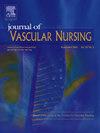Efficacy of life style modifications on severity, and operation rates for patients with peripheral artery disease
IF 1.2
Q3 NURSING
引用次数: 0
Abstract
Background: Peripheral artery disease is a circulatory problem causing reduced blood flow through the arteries. The study aimed to evaluate the efficacy of lifestyle modifications on severity and operating rates for patients with peripheral artery disease. Design and methods: An experimental study design was used with a purposive sample of 100 adult patients admitted to the vascular unit with peripheral artery disease aged ≥ 45 years. The study was carried out at the vascular surgery department and its outpatient clinic at Assiut University Hospital. Tools: (I) Patients’ interview questionnaire sheet; (II): Fagerström Tolerance Questionnaire; (III): The ankle-brachial index; (IV): The San Diego Claudication Questionnaire; and (V): Manipal lifestyle' modifications scale. Results: The mean age of patients in the study and control groups was 58.15±12.08 years. 84 % of study group patients experienced no pain, compared with 64 % of patients in the same group who experienced rest pain on admission. There was a decrease in amputation rates, with 12 % in the study group compared with 34 % in the control group of patients. More than three-quarters (76 %) had high lifestyle modification at follow-up compared with (96 %) of the study group having low lifestyle modification at admission. Conclusion and recommendation: Lifestyle modifications have a great effect on decreasing disease severity and operation rates. Peripheral artery disease patients should be included in a lifestyle modification program and closely monitored to decrease their disease severity and operative and amputation rates.
生活方式改变对外周动脉疾病患者严重程度及手术率的影响
背景:外周动脉疾病是一种引起动脉血流量减少的循环系统疾病。该研究旨在评估生活方式改变对外周动脉疾病患者的严重程度和手术率的影响。设计和方法:采用实验研究设计,目的样本为100例年龄≥45岁的外周动脉疾病患者。这项研究是在阿西尤特大学医院的血管外科及其门诊进行的。工具:(1)患者访谈问卷;(二):Fagerström宽容问卷;(III):踝臂指数;(四):圣地亚哥跛行问卷;(五):马尼帕尔生活方式改变量表。结果:研究组与对照组患者的平均年龄为58.15±12.08岁。研究组中有84%的患者没有疼痛,而同一组中有64%的患者在入院时出现静息性疼痛。截肢率下降,研究组为12%,对照组为34%。超过四分之三(76%)的患者在随访时生活方式改变程度较高,而在入院时生活方式改变程度较低的研究组中,这一比例为96%。结论和建议:生活方式的改变对降低疾病严重程度和手术成功率有重要作用。外周动脉疾病患者应纳入生活方式改变计划,并密切监测,以降低其疾病严重程度和手术和截肢率。
本文章由计算机程序翻译,如有差异,请以英文原文为准。
求助全文
约1分钟内获得全文
求助全文
来源期刊

Journal of Vascular Nursing
NURSING-
CiteScore
1.40
自引率
0.00%
发文量
33
期刊介绍:
Journal of Vascular Nursing provides clinical information regarding aortic and peripheral aneurysms, upper and lower extremity arterial disease, acute and chronic venous disease, and more. Original, peer-reviewed articles present descriptions, etiologies, diagnostic procedures, medical and surgical treatment and nursing implications of vascular system disorders.
 求助内容:
求助内容: 应助结果提醒方式:
应助结果提醒方式:


